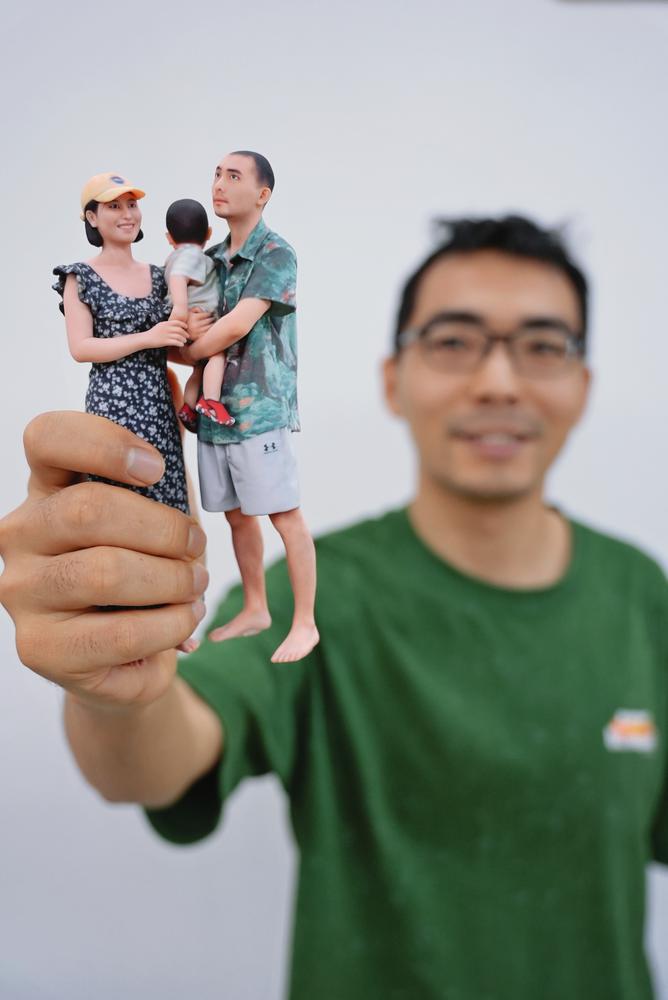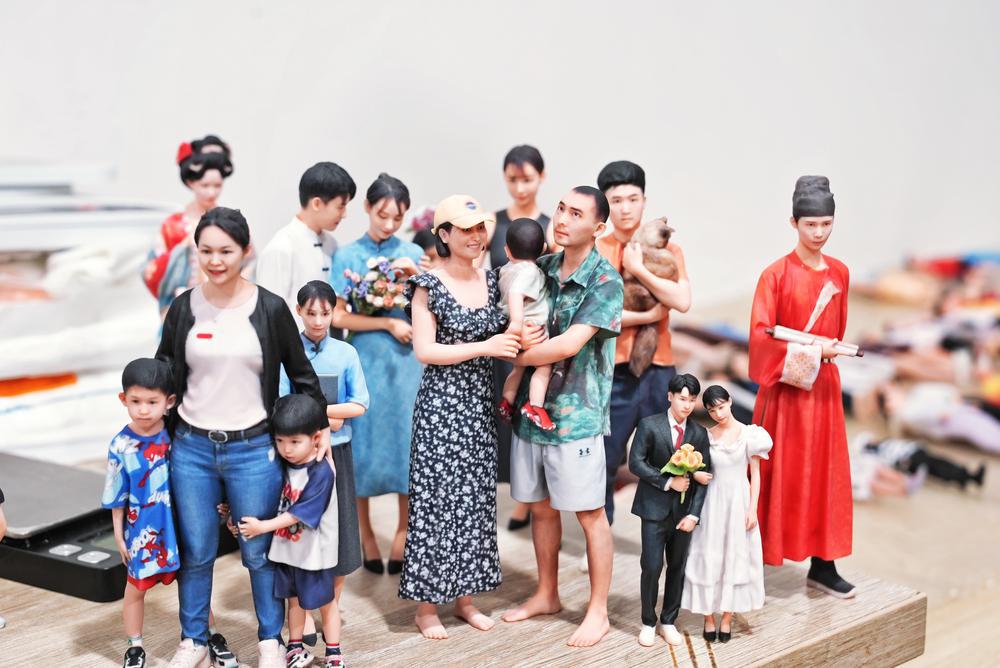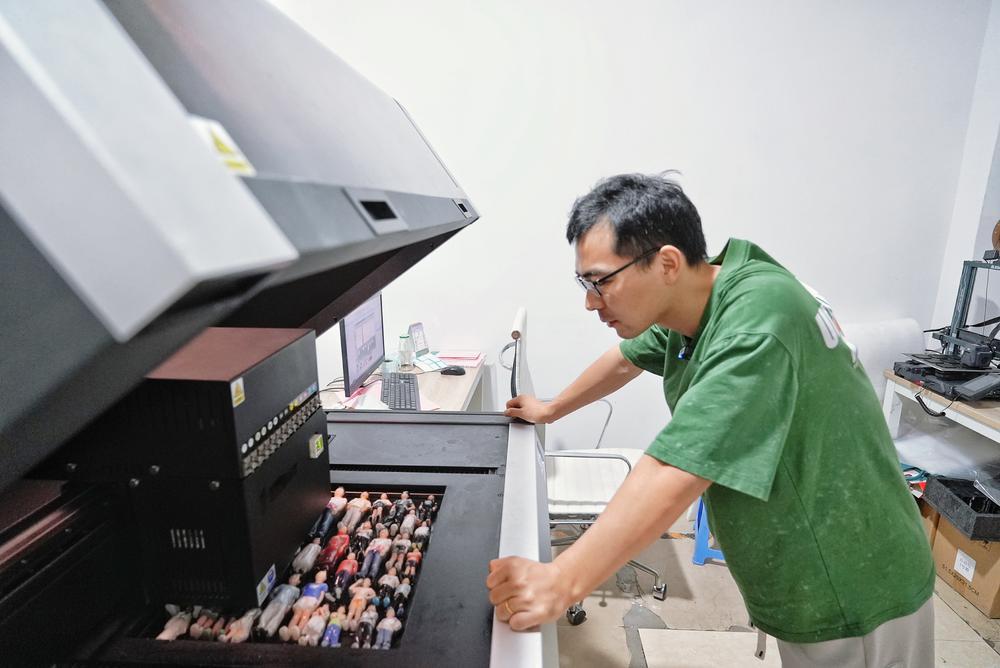
In the studio of Liu Shuai and Su Yuhong, a variety of figurines adorn the display stands. These figurines showcase diverse poses: some are seated cross-legged with hands clasped, some cradle kittens, and others are dressed in traditional Chinese attire waving to fans.

Unlike the factory-produced figurines from popular ACGN works, the figurines in Liu Shuai's studio are created using 3D printing from real-life models. Consumers stand in a camera matrix inside the studio, where 90 high-speed cameras capture images from 360 degrees. The images are then processed by a computer to create a 3D model, which is finally printed by a 3D printer.
The technology to produce these real-life figurines has existed for some time, but high costs have made it inaccessible to the general public. Liu Shuai and Su Yuhong have developed more cost-effective 3D data collection equipment, reducing the base price of a real-life figurine to 200 yuan. Liu mentioned that as technology advances, the price of these figurines could drop even further.

"This is a new way of commemoration," Liu explained to reporters. "We want to make this kind of keepsake something that everyone can easily afford."
Before entering the real-life figurine industry, Liu was a software engineer. At the beginning of 2022, he and his wife Su Yuhong were introduced to the technology of 3D printed figurines. Seeing a business opportunity, they decided to invest in the development and production of the necessary equipment. "Photos can capture beautiful moments, but they are ultimately 2D. 3D printing technology can provide a three-dimensional memory, making that moment of you, or your friends and family, come to life," Su stated.
In the 3D printing studio, Liu demonstrated to reporters how real-life figurines are "printed." He gently lifted the black light-shielding cover of the 3D printer, releasing a waft of resin odor - the "ink" used in 3D printing. Beneath the cover, over twenty half-formed figurines lay on the print bed. The machine moved back and forth above them, spraying layers of resin only 0.02 millimeters thick and adding color to the edges. After eight hours, with thousands of layers of resin stacked, the figurines began to take shape. The final steps of washing, sandblasting, glazing, and curing completed the creation of a real-life figurine.

Liu hopes to further reduce the consumer threshold for 3D-printed figurines in the future. His studio plans to launch a new 3D data collection device this year, which will only capture facial data and pair it with a cartoon body. The production cost for this will be less than 50 yuan.
"Currently, the cheapest real-life figurine is priced at 199 yuan, but the typical price is over 399 yuan. While this price isn't high for a keepsake with special significance, it's still quite steep for an ordinary consumer product. We aim to continue lowering the cost of 3D figurines, allowing more people to experience this new form of personalized consumption," Liu stated.
Source :Yangcheng Evening News
广州“90后”夫妇研发低成本3D打印技术
在刘帅和苏禹宏夫妇的工作室展台上,站着几十个人物手办。这些人物手办造型不一,有的盘腿坐着双手合十,有的怀里抱着小猫,还有的穿着古装挥舞扇子。
与近些年风靡的二次元动漫手办不同,刘帅工作室里的手办并非工厂量产,而是来自真人3D打印——消费者站在摄影棚里的相机矩阵里,90台高速摄影机360度环绕拍摄,再由电脑将图像合成为3D模型,最后由3D打印机进行打印。
制作真人手办的技术早已存在,但因为成本太高而让大众望而却步。刘帅和苏禹宏研发出了成本更低的3D数据采集设备,把一座真人手办的起步价格降到了200元。刘帅表示,随着技术发展,真人手办的价格还有很大的下降空间。
“这是一种新型的纪念方式”,刘帅告诉记者,“我们想让这种纪念品变成一个大众随手可以购买的东西。”
进入真人手办行业前,刘帅是一名软件工程师。2022年初,他和妻子苏禹宏接触到了3D打印手办这一技术;夫妻俩认为这是一个商机,于是决定投入这个行业的设备研发和制作。“照片可以留住美好的瞬间,但它终究是平面的,而3D打印技术可以提供一种立体的回忆,让这一瞬间的你,或者朋友、家人变得立体起来。”苏禹宏表示。
在3D打印工作室,刘帅向记者展示真人手办是如何被“打印”出来的。只见他轻轻掀开3D打印机的黑色遮光罩,一股树脂的气味扑鼻而来——这是3D打印的“墨水”。遮光罩下,二十多个已经半成型的真人手办“躺”在打印面板上,机器在其上方来回移动,喷涂一层又一层厚度只有0.02毫米的树脂,并在涂层边缘处添加颜色。八个小时后,在数千层树脂的堆叠下,手办初具雏形;再经过清洗、喷砂、上釉、固化等步骤,一座真人手办才大功告成。
刘帅希望未来3D真人手办的消费门槛能进一步降低。他的工作室计划在今年推出新款3D数据采集设备,这款设备仅采集人脸数据,再配上卡通身体,制作成本不到五十元。
“目前,真人手办最便宜的价格是199元,但一般消费价格在399元以上。虽然对于一个具有特殊意义的纪念品来说这个价格并不高,但对于一个普通消费品来说其实还是挺高的。我们想让3D手办的价格继续降下来,让更多人能够体验到这种新型的个性化消费。”
文|记者 谭洁文
图|记者 姜雪媛
译|刘佳慧
-
Would you consider placing tailored ads in Guangzhou metro stations?
2024-06-16 23:59:24 -
Guangzhou 'post-90s' couple develops low-cost 3D printing technology
2024-06-16 23:59:32 -
The Allure of Chinese Culture: The Irresistible Charm of Dragon Boat Racing
2024-06-16 00:15:12 -
17-year-old vocational school student ranks 12th in global math competition
2024-06-16 00:15:22






